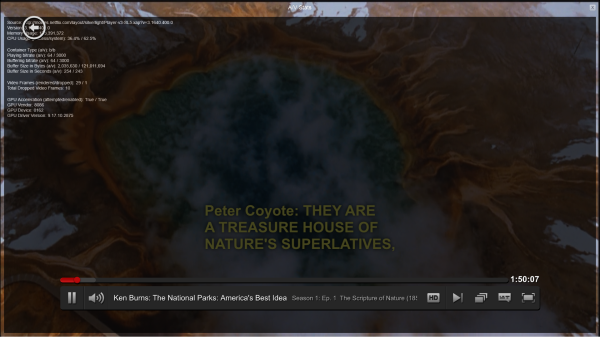Getting the Best out of an Ivy Bridge HTPC: Windows 8, madVR and More..
by Ganesh T S on January 20, 2013 3:00 PM EST- Posted in
- Home Theater
- Intel
- HTPC
- Ivy Bridge
- Windows 8
- Passive Cooling
Network Streaming Performance - Netflix
The drivers for the Intel HD 4000 enable hardware accelerated decode and rendering for Netflix streams in Silverlight on Windows 7. The Windows 8 Netflix app has been a bit of a mystery where it is not readily evident as to whether hardware acceleration is present or not, and whether it is being really utilized. In this section, we will take a look at how Netflix behaves on Windows 7 and Windows 8. The ISP at my location is Comcast, and unfortunately, there is no access to the Netflix 5 Mbps Super HD streams yet.
Netflix on Windows 7
On Windows 7, Netflix needs the Silverlight plug-in to be installed. We played back our standard test stream using Internet Explorer.
The Silverlight plug-in attempts GPU acceleration and enables it on our system. Manual stream selection is available. The maximum playback quality has a bitrate of 64 kbps for the audio and 3 Mbps for the video.
We will take a look at the efficiency of the system while playing back the stream towards the end of this section.
Netflix on Windows 8
On Windows 8, Netflix is streamed through a Metro app. Fortunately, the same debug shortcut keys used in the Silverlight version work here too. A nice add-on touch is that the manual stream selection and playback statistics OSD can be made to appear simultaneously.
It is not immediately evident as to whether hardware acceleration is being utilized or not. However, the aspect which stands out immediately is the fact that the video playback bitrate can go as high as 3.85 Mbps. Audio still remains at a lowly 64 kbps. Hopefully, a future update to the Netflix app can provide us with the soundtracks available on specialized media streamers.
Netflix Power Consumption - Windows 7 vs Windows 8
While the Silverlight plug-in OSD helpfully reports that GPU acceleration is being taken advantage of, it doesn't indicate the efficiency in any way. On the other hand, the Windows 8 app doesn't report GPU acceleration status at all. To determine the actual efficiency of Netflix playback, we recorded power consumption at the wall for both scenarios over a 10 minute interval during the middle of the stream.

The graph presents some very interesting results. With Windows 8, the system consumes much less power and the stream is also of higher quality. GPU acceleration in the app makes the streaming more than 30% efficient when compared to the Silverlight version. Compared to Windows 7 Silverlight, the Netflix app is efficient by approximately 35%. Windows 8, by itself, seems to consume less power too. Considering these results, if Netflix forms any part of your HTPC usage scenario, it is a no-brainer to upgrade from Windows 7 to Windows 8.













138 Comments
View All Comments
ganeshts - Tuesday, January 22, 2013 - link
I wish :) But, to be honest, MS doesn't even provide keys to us (We have to use the eval period, unactivated)That said, I first set up Win 8 for a relative on a newly purchased notebook, and I seriously hated it. Even now, I am not used to the various new features available to interact with the OS. But, I have now come to realize that, technically, the OS has some very interesting improvements in terms of efficiency and multimedia support (at least). Give the eval version a try without activating, you might be pleasantly surprised :)
glugglug - Wednesday, January 23, 2013 - link
Replacing multiple DVRs is the primary use of my PC..I suppose you could have a Media Center w/CableCARD build separate from the HTPC you have here, but IMO, Media Center is **the** killer HTPC app.
NikosD - Friday, January 25, 2013 - link
4K decoding ? Why not benchmark at that resolution ?Ivy and VP5 are the only GPUs (VPUs) capable of HW accelerated H.264 4K decoding.
CSMR - Sunday, January 27, 2013 - link
Power consumption of around 40W is high for doing something as simple as media playback.With an Ivy Bridge chip you should be able to get sub 20W easily, and in fact sub 10W is achievable (http://www.silentpcreview.com/forums/viewtopic.php...
For a fanless system, this is important and will improve reliability and difficulty of cooling.
mr0000000000 - Wednesday, January 30, 2013 - link
Lordy that thing is beautiful - is that just a rendering or does that actually exist?PokerGuy - Monday, February 4, 2013 - link
From the article: "I would strongly suggest HTPC users relying on WMC (irrespective of the OS) to move on to other platforms."What other platform could I move to that would allow me to use cablecard? I have HD Homerun Prime and absolutely love it. I can watch any and everything on any PC in the house, including my HTPC for my main tv in the living room. I use XBMC as my library manager for all my movies and music, but I can't use it with cablecard, so I still need WMC for that purpose.
Win 8 comes without WMC, unless you want to pay extra, so for me it's a step backwards from Win 7. Paying to downgrade in functionality doesn't seem like a good idea.
connor2k - Friday, February 15, 2013 - link
I have looked through most of the comments. Is it listed elsewhere?Deuge - Wednesday, September 18, 2013 - link
Hi Ganesh, i notice the new haswell NUC with HD5000 is coming out. Will you be doing an HTPC review of it?? Seems like the perfect HTPC to me.http://www.legitreviews.com/intel-nuc-kit-d54250wy...